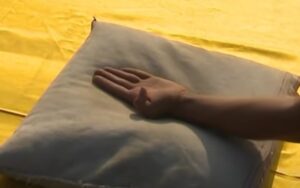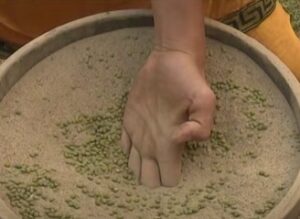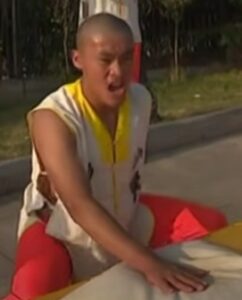In traditional Chinese martial arts, Tiě Shā Zhǎng (鐵沙掌, 鐵砂掌, or 鐵絲掌), also known as Tie Shou Gong (铁手功), toughens both hands and legs. Despite the different terms, they all share the same goal of hardening the hands.

Iron Palm refers to the outcome of intense training focused primarily on strengthening the palm of the hand, although other hand parts may also be involved (back of the hand, fist, fingertips, etc.). This training includes various methods to toughen the hand. Many Iron Palm systems are classified as internal, meaning they use qigong exercises to improve overall development alongside external conditioning. This training changes the internal structures of the hand, like bones and sinews, to make them stronger. However, martial artists who practice Iron Palm don’t all follow the same approach.
Let’s break down the term Tiě Shā Zhǎng 鐵沙掌.
- 鐵 (Tiě): This character means “iron” in Chinese. It represents strength and hardness.
- 沙 or 砂 (Shā): This character means “sand.” It could signify the use of sand in training or conditioning.
- 絲 (Sī): This character means “silk”, “thread” or “wire”. It typically symbolizes something fine, delicate, or flexible. “Tiě Sī Zhǎng” translates to “Iron Wire Palm”.
- The inclusion of “wire” could imply a focus on fine, precise, or controlled conditioning techniques.
- 掌 (Zhǎng): This character means “palm” or “hand.” It refers to the specific part of the body targeted in the training.
When translated, “Tiě Shā Zhǎng” means “Iron Sand Palm.” However, it is better interpreted as Iron Palm training. This term likely denotes a technique or training method aimed at strengthening the hand.
The Essence of Iron Palm Training.

Iron Palm Training is founded on the principle of conditioning both the hands (and legs) to withstand impact and deliver powerful strikes. The hands, regarded as essential tools in combat, undergo rigorous conditioning exercises to strengthen the bones, tendons, and muscles. Similarly, the legs, often overlooked but equally vital in martial arts, are also subjected to intensive training to develop strength, flexibility, and agility. Through consistent training, practitioners aim to cultivate a formidable striking ability capable of inflicting significant damage upon opponents using both their hands and legs.
This comprehensive training not only strengthens the physical aspects of the hands and legs but also enhances the practitioner’s mental focus and resilience. By pushing their physical and mental limits, practitioners develop a deeper understanding of their bodies and the martial arts techniques they employ, leading to heightened effectiveness in combat situations.
Techniques and Methods.
Iron Palm Training encompasses a variety of techniques and methods tailored to toughen the hands and develop striking power.
Palm Strikes and Iron Palm Bag Training.
Practitioners engage in a combination of palm strikes and iron palm bag training to fortify their striking abilities.

During palm strikes, practitioners repetitively strike designated training surfaces like sandbags, wooden posts, or specialized Iron Palm bags. Using various palm striking techniques, this repetitive impact gradually strengthens the hands and increases striking power, similar to the principles behind the Makiwara used in karate.
In iron palm bag training, specialized bags filled with malleable materials such as sand, beans, or gravel are employed to simulate striking resistance. Practitioners systematically strike the bag with different hand techniques, progressively intensifying the force and duration over time. This dual approach enhances the practitioner’s ability to deliver powerful and effective strikes while conditioning the hands for durability and resilience.
Breathing and Visualization.
Proper breathing techniques and mental focus play a crucial role in Iron Palm Training. Practitioners synchronize their breath with each strike, channeling internal energy, or “Qi,” to enhance striking power. Visualization techniques may also be employed to visualize the desired outcome and reinforce mental conditioning.
Leg Conditioning.
While much emphasis is placed on hand conditioning in Iron Palm Training, practitioners also engage in leg conditioning exercises to develop powerful kicking techniques. These exercises may involve striking heavy bags with the legs, practicing kicks against padded surfaces, and performing leg-strengthening exercises like squats and lunges. By conditioning both the hands and legs, practitioners ensure a well-rounded skillset and enhanced combat effectiveness.
This comprehensive approach to training ensures that practitioners develop not only physical strength and striking power but also mental focus and resilience, essential components of martial arts proficiency.
Where there is Damage, there is Healing.
In the rigorous training regimen of Iron Palm Training, injuries and strains are not uncommon. However, where there is damage, there is also a focus on healing and recovery. Alongside the intense physical conditioning, practitioners employ various methods to promote healing and soothe discomfort.
Herbal Soaks and Liniments.
Herbal concoctions, comprising a blend of medicinal herbs and oils, are commonly used in Iron Palm Training to promote healing and enhance conditioning. These herbal remedies are carefully crafted to accelerate the body’s natural healing processes, reducing inflammation, easing soreness, and promoting tissue repair.
Practitioners may soak their hands in herbal solutions, allowing the healing properties to penetrate deeply into the tissues. Additionally, liniments, which are topical herbal preparations, are applied directly to the affected areas to alleviate discomfort and stimulate circulation.
By incorporating herbal soaks and liniments into their recovery routine, practitioners not only expedite the healing process but also ensure that their hands remain resilient and prepared for the rigorous training ahead.
Thanks for taking the time to read my article.
Cheers Gert
